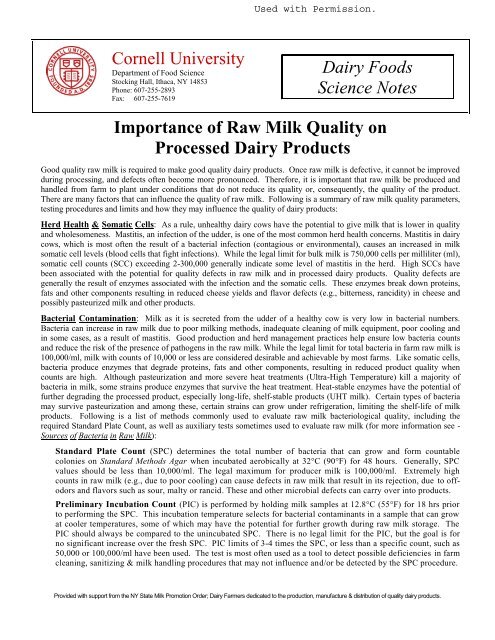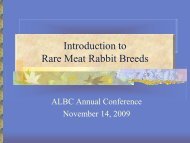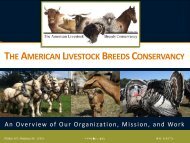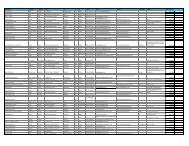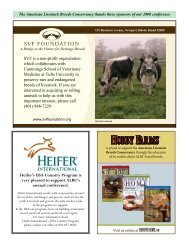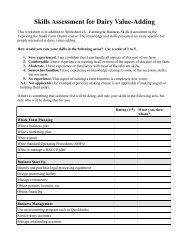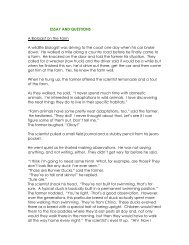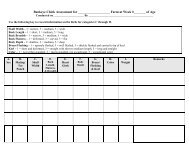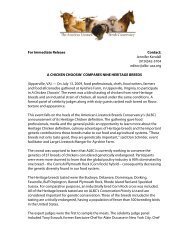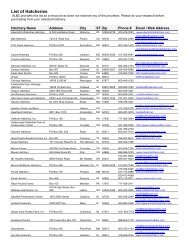Raw Milk Quality
Raw Milk Quality
Raw Milk Quality
You also want an ePaper? Increase the reach of your titles
YUMPU automatically turns print PDFs into web optimized ePapers that Google loves.
Cornell UniversityDepartment of Food ScienceStocking Hall, Ithaca, NY 14853Phone: 607-255-2893Fax: 607-255-7619Dairy FoodsScience NotesImportance of <strong>Raw</strong> <strong>Milk</strong> <strong>Quality</strong> onProcessed Dairy ProductsGood quality raw milk is required to make good quality dairy products. Once raw milk is defective, it cannot be improvedduring processing, and defects often become more pronounced. Therefore, it is important that raw milk be produced andhandled from farm to plant under conditions that do not reduce its quality or, consequently, the quality of the product.There are many factors that can influence the quality of raw milk. Following is a summary of raw milk quality parameters,testing procedures and limits and how they may influence the quality of dairy products:Herd Health & Somatic Cells: As a rule, unhealthy dairy cows have the potential to give milk that is lower in qualityand wholesomeness. Mastitis, an infection of the udder, is one of the most common herd health concerns. Mastitis in dairycows, which is most often the result of a bacterial infection (contagious or environmental), causes an increased in milksomatic cell levels (blood cells that fight infections). While the legal limit for bulk milk is 750,000 cells per milliliter (ml),somatic cell counts (SCC) exceeding 2-300,000 generally indicate some level of mastitis in the herd. High SCCs havebeen associated with the potential for quality defects in raw milk and in processed dairy products. <strong>Quality</strong> defects aregenerally the result of enzymes associated with the infection and the somatic cells. These enzymes break down proteins,fats and other components resulting in reduced cheese yields and flavor defects (e.g., bitterness, rancidity) in cheese andpossibly pasteurized milk and other products.Bacterial Contamination: <strong>Milk</strong> as it is secreted from the udder of a healthy cow is very low in bacterial numbers.Bacteria can increase in raw milk due to poor milking methods, inadequate cleaning of milk equipment, poor cooling andin some cases, as a result of mastitis. Good production and herd management practices help ensure low bacteria countsand reduce the risk of the presence of pathogens in the raw milk. While the legal limit for total bacteria in farm raw milk is100,000/ml, milk with counts of 10,000 or less are considered desirable and achievable by most farms. Like somatic cells,bacteria produce enzymes that degrade proteins, fats and other components, resulting in reduced product quality whencounts are high. Although pasteurization and more severe heat treatments (Ultra-High Temperature) kill a majority ofbacteria in milk, some strains produce enzymes that survive the heat treatment. Heat-stable enzymes have the potential offurther degrading the processed product, especially long-life, shelf-stable products (UHT milk). Certain types of bacteriamay survive pasteurization and among these, certain strains can grow under refrigeration, limiting the shelf-life of milkproducts. Following is a list of methods commonly used to evaluate raw milk bacteriological quality, including therequired Standard Plate Count, as well as auxiliary tests sometimes used to evaluate raw milk (for more information see -Sources of Bacteria in <strong>Raw</strong> <strong>Milk</strong>):Standard Plate Count (SPC) determines the total number of bacteria that can grow and form countablecolonies on Standard Methods Agar when incubated aerobically at 32°C (90°F) for 48 hours. Generally, SPCvalues should be less than 10,000/ml. The legal maximum for producer milk is 100,000/ml. Extremely highcounts in raw milk (e.g., due to poor cooling) can cause defects in raw milk that result in its rejection, due to offodorsand flavors such as sour, malty or rancid. These and other microbial defects can carry over into products.Preliminary Incubation Count (PIC) is performed by holding milk samples at 12.8°C (55°F) for 18 hrs priorto performing the SPC. This incubation temperature selects for bacterial contaminants in a sample that can growat cooler temperatures, some of which may have the potential for further growth during raw milk storage. ThePIC should always be compared to the unincubated SPC. There is no legal limit for the PIC, but the goal is forno significant increase over the fresh SPC. PIC limits of 3-4 times the SPC, or less than a specific count, such as50,000 or 100,000/ml have been used. The test is most often used as a tool to detect possible deficiencies in farmcleaning, sanitizing & milk handling procedures that may not influence and/or be detected by the SPC procedure.Provided with support from the NY State <strong>Milk</strong> Promotion Order; Dairy Farmers dedicated to the production, manufacture & distribution of quality dairy products.
Laboratory Pasteurization Count (LPC) is performed by heating the milk sample to 62.8°C (145°F) for 30min. (simulates batch pasteurization) followed by an SPC. This procedure counts bacteria that survivepasteurization (thermoduric bacteria). LPCs of less than 250/ml should be the goal. The legal maximum SPC forpasteurized milk is 20,000/ml. This test is also used as an indicator of possible deficiencies in farm procedures.Coliform Bacteria Count is performed by plating a sample on the media Violet Red Bile Agar, which selectsfor coliform bacteria. Coliforms are associated with fecal and environmental contamination. Counts of less than50/ml should be the goal; < 25 is achievable. There are no legal limits for raw milk, unless coliform cause theSPC to exceed 100,000/ml. Coliform are associated with filth contamination and a higher potential for pathogens.Antibiotics and Drug Residues: Antibiotics and other drugs are often used to treat cows with mastitis or otherinfections or ailments. When a cow is treated, its milk is generally withheld from the bulk tank until treatment stops andmilk is free of drug residues. The most commonly used drugs are the beta-lactam antibiotics (i.e., the penicillin family).Occasionally treated cows are overlooked and antibiotic contaminated milk enters the bulk tank. However, all raw milktank trucks are screened for the presence of beta-lactam drugs at dairy plants before they are unloaded, thereforeminimizing the potential for drug contaminants in processed dairy products. Individual farm samples are also testedroutinely or for producer trace-back if a truck tests positive. Antibiotics in milk are a concern due to the risk of allergicreactions and the development of antibiotic resistant pathogens. During the manufacture of cheese and cultured dairyproducts, antibiotics can inhibit dairy starter cultures used to develop acid (e.g., lactic acid bacteria), which can result inthe loss of significant amounts of product and milk.Water & Freezing Point of <strong>Milk</strong>: Added water can occur in milk due to both unintentional (e.g., poor systemdrainage) and intentional addition. Added water can be detected in milk by measuring its freezing point. The freezingpoint is slightly less than that of pure water and relatively constant. Typical milk generally has a freezing point belowminus 0.542 degrees Hortvett, (°H is a scale used almost exclusively for milk freezing point, a derivative of degreesCelsius). When water is added to milk, the freezing point increases approximately 0.005°H for every 1% water added.NY State uses a cut-off of -0.530°H or higher (less negative) as cause for investigation. Added water reduces the valueof the milk by diluting the protein and other milk components that will influence product yields. Added water in fluidmilk can also dilute the sweetness, potentially resulting in a “flat” taste.Sediment: Sediment in milk is generally due to poor pre-milking hygiene procedures that allow soil and other materialsto enter the milking stream. Proper environmental conditions for cow cleanliness are important to reduce soil on animalsso that pre-milking hygiene procedures can be effective. Sediment in milk is measured by filtering the milk through afine filter and visually examining it. High sediment levels in milk are associated with filth and the potential for bacterialcontaminants that will influence quality.Farm Related Off-Flavors: Off-flavors and odors can be present in raw milk due to practices on the farm. Some areminor and difficult to avoid, while others are due to poor practices and can be reason for rejecting a milk load. Mostflavor/odor defects will be carried over into the finished product, although some of the volatile defects can be partiallyremoved. Defects in milk can be classified as Absorbed – cows breathing in odors in the air can transmit these to themilk through their blood stream while some odors can be directly absorbed by the milk during storage;. Bacterial –growth of spoilage microorganisms; or Chemical – related enzymes, feed and health of the cow as well as milk handlingprocedures (e.g., cleaning chemicals). For more information see the handout Flavor & Odor Defects in <strong>Milk</strong>. The mostcommon raw milk related off-flavors/odors and their causes are:Barny/Cowy: Associated with strong barn odors (e.g., poor barn aeration) absorbed by the cow or the milk duringstorage. Some animals will produce “cowy” milk that is related to poor animal health (e.g., ketosis).Feedy: Associated with strong feed odors that are absorbed by the cow or directly into the milk during storage.Feed flavors/odors most often mimic the nature of the feed (e.g., silage, hay, soy). They are often present in lowlevels not considered objectionable, although strong feed flavors/odors, especially those related to poor quality feeds,may be cause to reject milk. Feed flavors can be minimized by not feeding immediately before milking. Relatedoff-flavors include those of wild onion/garlic (especially in the south).Malty/Acid/Sour: Due to the growth of bacteria that produce acid, some of which can produce a “malty” defect.Most often associated with poor cooling of the milk (e.g., from a farm with a broken compressor).Oxidized: Cardboardy or “old-oil” odor and flavor resulting from the oxidation of milk fats in the presence ofmetals (such as copper contamination). Feeds high in certain fats (e.g., soy beans) and or low levels of vitamin E inthe cows’ diet may also increase the milk’s susceptibility to oxidation.Provided with support from the NY State <strong>Milk</strong> Promotion Order; Dairy Farmers dedicated to the production, manufacture & distribution of quality dairy products.
Rancid: Sour-like defect that occurs in milk due to excessive agitation and other factors related to increasing thesusceptibility of the milk fat to the hydrolytic enzyme lipase. Lipase breaks down butter fat to free fatty acids (suchas butyric) that can result in rancid off-flavors (e.g., soapy, baby-vomit, blue cheese).Provided with support from the NY State <strong>Milk</strong> Promotion Order; Dairy Farmers dedicated to the production, manufacture & distribution of quality dairyproducts.


